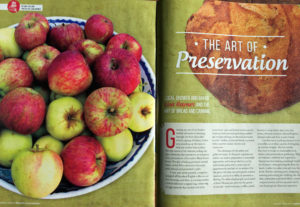![]() November/December 2015
November/December 2015
 Growing up, one of my fondest holiday memories is storming through our front door after school, ripping off snowy clothes and pounding up the stairs to help my mother bake cookies. She was serene in her element, rolling out spicy creations, like zimtsterne or cinnamon stars, reminiscent of her native Black Forest home. Rounds of baking produced myriad treats, which Mom plattered, festooned with ribbons and presented as gifts.
Growing up, one of my fondest holiday memories is storming through our front door after school, ripping off snowy clothes and pounding up the stairs to help my mother bake cookies. She was serene in her element, rolling out spicy creations, like zimtsterne or cinnamon stars, reminiscent of her native Black Forest home. Rounds of baking produced myriad treats, which Mom plattered, festooned with ribbons and presented as gifts.
Later, and newly married, a neighbor dropped off decadent English toffee on our first doorstep, and then, as a young mother, a friend delivered a zippered bag, containing an egg casserole that needed only to be poured into a pan and baked on that special morning. Such personal gestures propelled me to begin sharing a traditional sentiment as well—stollen, or almond bread, crammed with amaretto-soaked cherries and cranberries.
The advantages for the gifter and gifted are many. As the giver, expenses are within our control, preparation is seasonally appropriate, and mass production can be individually portioned to cover a list of acquaintances, teachers or co-workers. For the given, the treat can serve guests, imbues kindness, and as it is edible, its presence is fleeting. No white elephant gift need crowd a closet. Homemade gifts run the gamut to include: snack mixtures, truffles, jarred brownie or soup mixes, spice rubs, hot sauces, chutneys and jams, flavored liquors, infused vodka and fruit or yeast breads.
Lisa Rayner is a self-proclaimed do-it-yourselfer, more than capable of whipping up kitchen delights. She has written four how-to books on sustainable food, textiles and permaculture gardening. They are volumes crafted by her experience. Rayner has been baking sourdough bread for 20 years—even grinding the flour by hand—cooks in a solar oven and cans local foods. Besides spinning yarn, designing, weaving and sewing her clothing, she also felts, embroiders and beads fabric, creates original jewelry and incorporates shells into home goods. From her expansive knowledge of home arts, Rayner offered advice on baking bread and canning fresh produce.
“I wanted to try to be more self-sufficient and enjoy the superior homemade characteristics of sourdough breads and canned foods,” Rayner said. “I also wanted to eat as much locally and regionally grown foods as possible—it just tastes better.” High quality ingredients and local products often contain distinct characteristics. For example, wheat varieties vary from region to region, offering specific bread types.
“I am addicted to my bread,” Rayner admitted. For flour ground by hand or an electric mill, the difference lies in the freshness. Oil in whole grains is super-polyunsaturated, like flax and hemp oils. Commercial whole grain flours should always be stored in the freezer to avoid becoming rancid. Sourdough relies on a living culture, or starter, which contains multiple species of wild yeast and lactic acid bacteria, requiring care to remain vigorous. Still, baking simple sourdough breads is easy—kneading takes five minutes, and loaf breads only require one rise. “The amount of water in the dough determines the range of breads from dense bagels to airy ciabatta.” Artisan breads are shaped from stickier and trickier doughs to handle, with weighted measures for greater precision.
Canning has made a comeback, with creativity limited only by access. The Southwest has unique species of wild and domesticated fruits and vegetables not often canned commercially. Rayner forages for free urban fruit, especially apples, but also cherries, plums and pears when available. She buys discounted cases of tomatoes, cucumbers and beets “seconds” from local farmers—ideal for jarring. There are strict guidelines to employ for safety. For help, readers can search for classes offered by institutions, local businesses, and private individuals or turn to the National Center for Home Food Preservation, which offers an online canning course (http://nchfp.uga.edu). High acid fruit slices or fruit preserves, sweetened with granulated sugar or honey, are the only foods that can be canned without a formal, tested recipe.
Increased interest in native products has bumped up their availability. Rayner noticed, “The same people who prefer to cook with local foods also want to preserve their own foods, usually for reasons of self-sufficiency, a greater sense of community and to enjoy the distinctive flavors of local ingredients.”
Whether it is crunchy cookies, canned snap beans or fresh sourdough bread, favorite foods and recipes double as gifts when prettily packaged, extending the warmth of your hearth to another’s home.
NAMLM Gail G. Collins
To learn more: www.lisarayner.com
